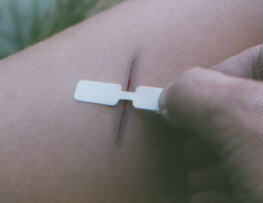Butterfly bandages are adhesive bandages that can be used in place of sutures to close a laceration under some conditions. A laceration is a break in the skin caused by a sharp object or puncture of some kind. Butterfly bandages are easy to make and use.
Under normal conditions, treat a laceration at home only if it’s small, shallow, and the skin along the laceration matches up perfectly (and remains together when undisturbed). If possible, you should see the doctor for lacerations where:
- The cut is gaping.
- The edges can be pulled more than 1/8 inch apart with traction on nearby skin.
- The cut is over a knuckle. the cut is on the face or genitals.
- The cut might be contaminated with foreign material the cut was caused by human or animal teeth.
- There is numbness, deep pain, or inability to move a part fully.
Butterfly bandages do not work well over moveable joints such as your knee, knuckle or elbow. These may require sutures because the movement of the joint will pull on the cut and cause it to gape. If you decide to treat a sharp laceration over a moving surface (such as knee, elbow, or knuckle), you need to provide protection against motion for the first few days.
If possible, deep lacerations need to be looked at by a doctor and probably sutured. Lacerations of the face that may cause disfigurement need to be looked at by a doctor and possible sutured.
How to make and apply a butterfly bandage
- Cut off a piece of tape that is about 1 inch to 1 1/2 inches in length.
- Fold the piece of tape in half so that the non-sticky sides are against one another.
- Cut a small triangular notch on one side of the tape, beginning about a quarter of the way down from the folded edge and cut angling up toward—but not all the way to—the center of the folded edge.
- Repeat on the other side, cutting a triangular notch that matches the one you just cut.
- Unfold the tape so the sticky side is facing up.
- The tape should look like it has a bow-tie shape in the middle.
- Fold the center flaps across the middle of tape, sticky side in, so they overlap. This will prevent the adhesive from sitting directly on top of the wound.
- Apply the bandage by sticking one end of the tape on one side of the wound, gently holding the edges of the wound together, pulling the tape across the wound, and sticking its other end in place.
- The narrow middle of the tape should be positioned over the edges of the wound.
- If the wound is long, make and apply as many butterfly bandages as needed along its length.

How Long Should You Leave a Butterfly Bandage on a Cut?
If you’re treating the cut at home, leave the butterflies on until they peel off on their own. Keep the wound covered with a dry dressing and keep it clean. Avoid bumping the area. It can take as long as 10 and 14 days before the cut is healed
Watch for:
See the doctor if there is redness around the wound, red streaks, swelling, drainage, fever, tender bumps in the groin or armpit upsteam from the wound, or an unexplained increase in pain or tenderness.



A friend a was showing me about this. Works great.